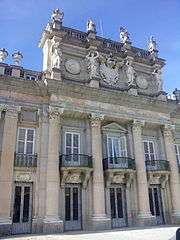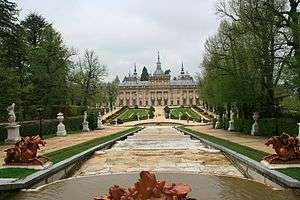Royal Palace of La Granja de San Ildefonso
%2C_pres_S%C3%A9govie%22_(19316045903).jpg)
The Royal Palace of La Granja de San Ildefonso (Spanish: Palacio Real de La Granja de San Ildefonso), known as La Granja, is an early 18th-century palace in the small town of San Ildefonso, located in the hills near Segovia and 80 kilometres (50 mi) north of Madrid, within the Province of Segovia in central Spain
It became the summer residence of the Kings of Spain from the 1720s during the reign of Philip V. The palace is in a restrained Baroque style, surrounded by extensive gardens in the formal Jardin à la française style with sculptural fountains. It is now open to the public as a museum.
History
.jpg)

The area was a favourite hunting grounds for many Castilian kings, due to its location on the forested northern slopes of the Sierra de Guadarrama. In the 15th century, Henry IV of Castile built the first hunting lodge on the site, along with a small shrine dedicated to San Ildefonso (saint Ildephonsus of Toledo), which gave this place its first name.
Isabella I of Castile granted both buildings to the monks of the Santa Maria del Parral monastery in Segovia, who built an almshouse and developed a granja (farm) alongside the lodge and shrine.
Palace
The site was purchased from the monks in 1719 by King Philip V, after his summer palace nearby at Valsaín burned to a shell. He was the first Spanish king from the French Bourbon dynasty. Beginning in 1721, Philip began building a new palace and gardens modeled on Versailles, built by his grandfather, Louis XIV of France. Like Versailles it embraced a cour d'honneur on the approaching side, and formal gardens, with a main axis centred on the palace, that were surrounded by woodland in which further hidden garden features were disposed. Like Versailles, La Granja began as a retreat from the court but became a centre of royal government.
For the architect, Philip began with an unpretentious project by the Spanish architect Teodoro Ardemans, incorporating a chapel centred on one facade, which was enlarged in a second phase, ca 1728-34 under Andrea Procaccini and Sempronio Subisati, who provided the courtyards in the flanks, then given its definitive character by Filippo Juvarra, who was brought from Turin, based on recommendations in the circle of Philip's second queen, Elizabeth Farnese of Parma,[1] and his assistant, Giovanni Battista Sacchetti.
When the King decided to abdicate in 1724, his intention was to retire to La Granja. Unfortunately Philip's heir, King Louis I, died that same year, and Philip had to return to the throne. Consequently, a place designed for leisure and quiet retreat thus became an important meeting place for the King, his ministers and the court.[2] The town of San Ildefonso expanded to provide housing and services to the courtiers who wanted a place near the king's favourite residence. Military barracks, a collegiate church (1721–1724, built to designs of Teodoro Ardemans, and dedicated to the Holy Trinity, 22 December 1723), and even a royal glass factory (1728) were built to provide for the palace. The glass factory, which had some initial successes from 1720 at Nuevo Baztan in the province of Madrid, was moved under the direction of its Catalan foreman, Ventura Sit, to San Ildefonso, where supplies of timber were plentiful, and a royal patron was near. The best glass of Venetian type produced in the works dates from the last quarter of the 18th century.[3] As La Granja de San Ildefonso, the glassworks continue today as a subsidiary of Saint Gobain.
The church was selected as his burial site by Philip, marking a break with his Habsburg predecessors. The frescoes by Giambattista Tiepolo, completed by Francisco Bayeu, were badly damaged in a fire of 1918.[4]
Philip's successor Ferdinand VI bequeathed the royal site of San Ildefonso, with all it contained, to his father's second wife, Isabel Farnese. At her death in 1766, it reverted to the Crown in the person of Charles III.
For the next two hundred years, La Granja was the court's main summer palace, and many royal weddings and burials, state treaties, and political events took place within its walls.
Currently the royal site is part the Patrimonio Nacional of Spain, which holds and maintains many of the Crown's lands and palaces. [5] It is a popular tourist attraction, with gardens, and interiors displaying rooms with marble from Carrara, Japanese lacquer, and crystal chandeliers; portraits and other paintings; and a Museum of Flemish tapestries. [6]
Gardens
Extending over 1,500 acres (6.1 km2), the gardens around the palace are one of the best examples of 18th-century European garden design in the Jardin à la française style in Spain. [7] The French designer from the official French royal offices of Robert de Cotte was René Carlier,[8] who used the natural slope of the site in the palace grounds design, for enhancing axial visual perspectives, and to provide sufficient head for water to shoot out/up from the twenty-six sculptural fountains in the formal gardens and landscape park.
Sculptors arrived from Paris to execute designs on the site. They included: René Frémin (1672–1744, at La Granja until 1738), to whom the execution of many vases and sculptures was attributed in 18th-century inventories; Jean Thierry; and others who are little more than names in archival references.

Fountains
All of the fountains represent themes from classical mythology, including Greek deities, allegories and scenes from myths. They are cast in lead to prevent corrosion, and painted over to simulate bronze, a nobler material, or lacquered over white oxydised lead to imitate marble. A group of richly sculptural vases have been attributed to designs by the "dazzling maverick" Gilles-Marie Oppenord,[9] which were probably forwarded through the offices of Robert de Cotte, overseeing French royal building projects as intendant des Bâtiments du Roi. Bruno Pons noted in the sculptural vases "an almost excessively brilliant style, quite distinct from French royal taste and showing an undeniably superior understanding of ornament".[10]
The "Baths of Diana" fountain is the focal point of several garden alleés, and was made from lead and then painted to look like bronze and marble. It and its marble statues form some of the most impressive and well conserved architecture from this period in Spain. Fremin, Thierry, and Bousseau led a team of sculptors who between 1720 and 1745 created this stunning feature, brought to life by the fountains' spectacular water displays. However, regarding the elaborate "Baths of Diana", the chronically depressed Philip remarked, "It has cost me three millions and amused me three minutes."
The original waterworks and piping are still functional. They rely purely on gravity to project water up the fountain jets, including to the 40 metres (130 ft) height of the "Fame" fountain. A reservoir, El Mar (the Sea), lies secluded at the highest point of the landscape park, and provides the supply and water pressure for the whole system.
In the present day, only a few fountains are active on each day. Twice a year, on the feast days of San Fernando and of San Luis, all twenty-six fountains are set to jet and flow, providing memorable experiences.
Gallery
 La Granja facade at Patio de la Herradura.
La Granja facade at Patio de la Herradura.- Patio de la Herradura cour d'honneur courtyard.
.jpg) Fountains and Patio de Coches facade.
Fountains and Patio de Coches facade. Fountain in the gardens of La Granja.
Fountain in the gardens of La Granja. Fountain and music temple in gardens.
Fountain and music temple in gardens.- Royal chapel at La Granja.
- Facade detail.
 Sphinx on rear terrace at La Granja.
Sphinx on rear terrace at La Granja. Interior of Retreat Room.
Interior of Retreat Room. Funerary Monument of King Philip V and Elizabeth Farnese, by Dumandre & Puthois.
Funerary Monument of King Philip V and Elizabeth Farnese, by Dumandre & Puthois.
See also
- Buildings inspired by Versailles
- Gardens in Spain
References
- ↑ His first consort had been Maria Luisa of Savoy from the House of Savoy, the great patrons of Juvarra, but the court style during her lifetime was resolutely French
- ↑ Yves Bottineau, L'Art de Cour dans l'Espagne de Philippe V 1700-1746 (Bordeaux, 1965) sets the construction of La Granja in the broader context of court art.
- ↑ Frank Gibson, "La Granja Glass" The Burlington Magazine for Connoisseurs 39 No. 225 (December 1921), pp. 304, 308-309.
- ↑ Xavier Bray, "The Iconography of Francisco Bayeu's Frescoes for the Colegiata at La Granja de San Ildefonso" The Burlington Magazine 139 No. 1133 (August 1997, pp. 543-547), p. 543; José Manuel de la Mano, "Tiepolo's Commission for the Collegiate Church of the Holy Trinity at La Granja de San Ildefonso" The Burlington Magazine 139 No. 1133 (August 1997), pp. 536-543)
- ↑ Patrimonio Nacional: Royal Palace of La Granja de San Ildefonso
- ↑ Spain.info: La Granja de San Ildefonso Royal Palace
- ↑ Patrimonio Nacional: Gardens of the Royal Palace of La Granja de San Ildefonso, "History" tab.
- ↑ Carlier died in 1722, having laid out the main structural features, it is assumed. Esteban Boutelou continued in his place. The main source for information on the gardens is still Jeanne Digard, Les jardins de la Granja et la sculpture décorative (Paris) 1934.
- ↑ Bruno Pons, "Oppenord and the Granja de San Ildefonso" The Burlington Magazine 131 No. 1034 (May 1989), pp. 337-341, based on drawings at the Victoria and Albert Museum and among Robert de Cotte's papers at the Bibliothèque Nationale. The discovery in Spain of an Oppenord sketchbook of iconography opens the possibility that Oppenord travelled to Spain. (Pons 337, note 7)
- ↑ Pons 1989:340.
External links
- Patrimonio Nacional: Royal Palace of La Granja de San Ildefonso website
- Spain is culture.com: Gardens at La Granja de San Ildefonso
- Musique09.free.fr: Photographs of Palacio La Granja de San Ildefonso
Coordinates: 40°53′51″N 4°00′16″W / 40.89750°N 4.00444°W
| Wikimedia Commons has media related to Royal Palace of La Granja de San Ildefonso. |
